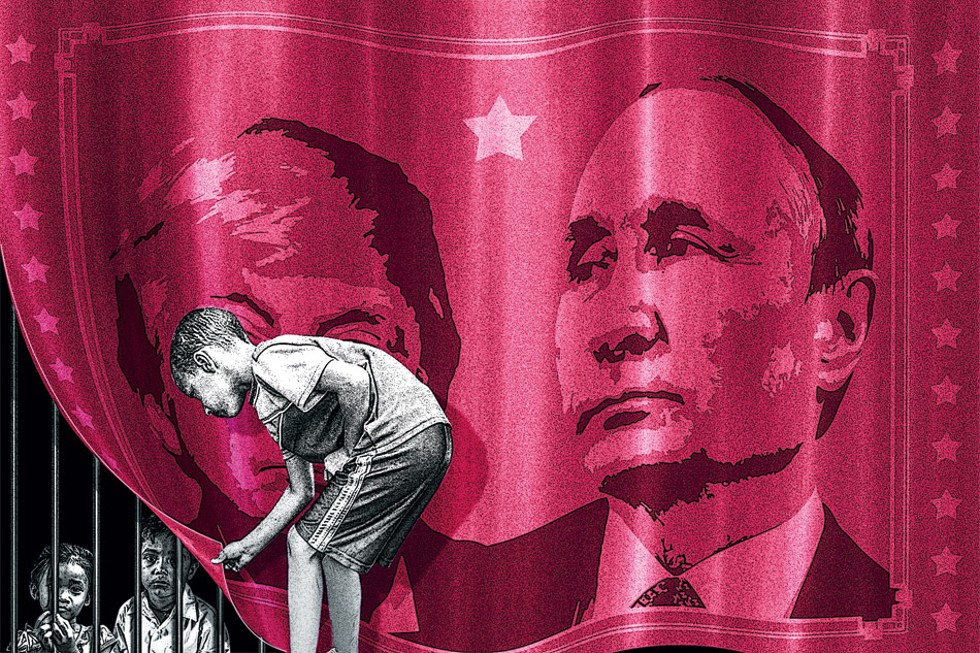
[
{
"name": "500x250 Ad",
"insertPoint": "5",
"component": "15667920",
"parentWrapperClass": "",
"requiredCountToDisplay": "1"
}
]
Fake news is not a new thing, and the new edition of Project Censored selections – the list of the year's most important but unreported or under-reported stories – uses a reference to a 1938 fake news story as an illustration. The cover art for the latest Project Censored book, "Censored 2019: Fighting the Fake News Invasion," recalls HG Wells' "War of the Worlds."
The situation today may feel as desolate as the cover art suggests. "But Censored 2019 is a book about fighting fake news," editors Andy Lee Roth and Mickey Huff observe in the book's introduction.
In the end, they argue that "critical media education — rather than censorship, blacklists, privatized fact-checkers, or legislative bans — is the best weapon for fighting the ongoing fake news invasion."
Censorship and fake news are "intertwined issues," Roth and Huff write.
The cover art theme works at two levels, as the editors explain. The famous Orson Wells radio broadcast of the "War of the Worlds" on October 30, 1938, presented a drama as though it were an actual crisis in progress. It became an example of the potential power of fake news in the radio media era.
"The broadcast became legendary for allegedly leading to widespread panic throughout the United States," the Project Censored editors write. But as Jefferson Pooley and Michael J. Socolow have documented in a series of articles over the past decade, both the audience size and degree of panic have been significantly inflated.
The top 10 of this year's 25 Project Censored stories:
1) Global decline in the rule of law as basic human rights diminish
According to the World Justice Project Rule of Law Index 2017–2018, released in January 2018, a striking worldwide decline in basic human rights has driven an overall decline in the rule of law since October 2016, the month before Trump's election.
Fundamental rights — one of eight categories measured — declined in 71 out of 113 nations surveyed. Overall, the scores of 34 percent of the countries declined, while those of just 29 percent improved. The United States ranked 19th, down one from 2016, with declines in checks on government powers and deepening discrimination.
Fundamental rights include absence of discrimination, right to life and security, due process, freedom of expression and religion, right to privacy, freedom of association, and labor rights.
Constraints on government powers saw the second greatest declines (64 countries out of 113 dropped). This is where the United States saw the greatest deterioration, World Justice Project stated in a press release. "While all sub-factors in this dimension declined at least slightly from 2016, the score for lawful transition of power — based on responses to survey questions on confidence in national and local election processes and procedures — declined most markedly," the press release stated.
The United States also scored notably poorly on several measurements of discrimination. "With scores of .50 for equal treatment and absence of discrimination (on a scale of 0 to 1), .48 for discrimination in the civil justice system, and .37 for discrimination in the criminal justice system, the US finds itself ranked 78 out of 113 countries on all three subfactors," World Justice Project stated.
The four Nordic countries — Denmark, Norway, Finland, and Sweden — remained in the top four positions. New Zealand, Canada, and Australia were the only top 10 countries outside of Europe.
"The WJP's 2017–2018 Rule of Law Index received scant attention from US corporate media," Project Censored noted. The only coverage Project Censored found was a Newsweek article drawing on The Guardian's coverage. This pattern of ignoring international comparisons, across all subject matter, is pervasive in the corporate media. It severely cripples our capacity for objective self-reflection and self-improvement as a nation.
2) "Open-source" intelligence secrets sold to highest bidders
In March 2017, WikiLeaks released Vault 7, a trove of 8,761 leaked confidential CIA files about its global hacking programs. It drew significant media attention. But almost no one noticed what George Eliason of OpEdNews pointed out.
"Sure, the CIA has all these tools available," Eliason said. "Yes, they are used on the public. The important part is it's not the CIA that's using them. That's the part that needs to frighten you."
The CIA's mission prevents it from using the tools, Eliason noted, especially on Americans. "All the tools are unclassified, open-source, and can be used by anyone," Eliason said. Drawing heavily on more than a decade of reporting by Tim Shorrock for Mother Jones and the Nation, Eliason's OpEdNews series reported on the explosive growth of private contractors in the intelligence community, which allows the CIA and other agencies to gain access to intelligence gathered by methods they're prohibited from using.
In a 2016 report for The Nation, Shorrock had concluded that "not only has intelligence been privatized to an unimaginable degree, but an unprecedented consolidation of corporate power inside US intelligence has left the country dangerously dependent on a handful of companies for its spying and surveillance needs."
Eliason reported how private contractors pioneered open-source intelligence by circulating or selling the information they gathered before the agency employing them had reviewed and classified it; therefore, "no one broke any laws." As a result, according to Eliason's second article, "People with no security clearances and radical political agendas have state-sized cyber tools at their disposal, [which they can use] for their own political agendas, private business, and personal vendettas."
Corporate media reporting on Vault 7 sometimes noted but failed to focus on dangerous role of private contractors, Project Censored says. A notable exception was a Washington Post op-ed in which Shorrock reviewed his previous reporting and concluded that overreliance on private intelligence contractors was "a liability built into our system that intelligence officials have long known about and done nothing to correct."
3) World's richest 1 percent continue to become wealthier
In November 2017, Credit Suisse released its 8th Annual Global Wealth Report, which The Guardian reported on with the headline "Richest 1% Own Half the World's Wealth, Study Finds."
The wealth share of the world's richest people increased "from 42.5% at the height of the 2008 financial crisis to 50.1% in 2017, or $140tn (£106tn)," The Guardian reported, adding that the biggest losers "are young people who should not expect to become as rich as their parents."
"No other part of the wealth pyramid has been transformed as much since 2000 as the millionaire and ultra-high net worth individual (known as UHNWI) segments," the report said. "The number of millionaires has increased by 170%, while the number of UHNWIs (individuals with net worth of USD 50 million or more) has risen five-fold, making them by far the fastest-growing group of wealth holders."
"At the other end of the spectrum, the world's 3.5 billion poorest adults each have assets of less than $10,000," The Guardian reported. "Collectively these people, who account for 70% of the world's working age population, account for just 2.7% of global wealth."
"Tremendous concentration of wealth and the extreme poverty that results from it are problems that affect everyone in the world, but wealth inequalities do not receive nearly as much attention as they should in the establishment press," Project Censored noted.
4) How big wireless convinced us that cell phones and wi-fi are safe
Are cell phones and other wireless devices really as safe we've been lead to believe? We shouldn't bet on it, according to decades of buried research reviewed in a March 2018 investigation for The Nation by Mark Hertsgaard and Mark Dowie.
"The wireless industry not only made the same moral choices that the tobacco and fossil-fuel industries did, it also borrowed from the same public relations playbook those industries pioneered," Hertsgaard and Dowie reported. "Like their tobacco and fossil-fuel brethren, wireless executives have chosen not to publicize what their own scientists have said about the risks of their products."
"On the contrary," they said, "the industry — in America, Europe, and Asia — has spent untold millions of dollars in the past 25 years proclaiming that science is on its side, that the critics are quack, and that consumers have nothing to fear."
Their report comes at the same time as several new developments are bringing the issue to the fore, including a Kaiser Permanente study (published December 2017 in Scientific Reports) finding much higher risks of miscarriage; a study in the October 2017 American Journal of Epidemiology, finding increased risk for glioma (a type of brain tumor); and a disclosure by the National Frequency Agency of France that nine out of ten cell phones exceed government radiation safety limits when tested in the way they are actually used, next to the human body.
The Kaiser Permanente study involved exposure to magnetic field non-ionizing radiation associated with wireless devices as well as cell phones and found a 2.72 times higher risk of miscarriage for those with higher versus lower exposure. Lead investigator De-Kun Li warned that the possible effects of this radiation have been controversial because, "from a public health point of view, everybody is exposed. If there is any health effect, the potential impact is huge."
"The wireless industry has 'war-gamed' science by playing offense as well as defense, actively sponsoring studies that result in published findings supportive of the industry, while aiming to discredit competing research that raises questions about the safety of cellular devices and other wireless technologies," Project Censored summarized. "When studies have linked wireless radiation to cancer or genetic damage, industry spokespeople have pointed out that the findings are disputed by other researchers."
While some local media have covered the findings of a few selected studies, Project Censored note, "the norm for corporate media is to report the telecom industry line — that is, that evidence linking Wi-Fi and cell phone radiation to health issues, including cancer and other medical problems, is either inconclusive or disputed.
5) Washington Post bans employees from using social media to criticize sponsors
On May 1, 2017, the Washington Post introduced a policy prohibiting its employees from criticizing its advertisers and business partners, and encouraging them to snitch on one another.
"A new social-media policy at The Washington Post prohibits conduct on social media that 'adversely affects The Post's customers, advertisers, subscribers, vendors, suppliers or partners," Andrew Beaujon reported in The Washingtonian the next month. "In such cases, Post management reserves the right to take disciplinary action 'up to and including termination of employment.'" Beaujon also cited "a clause that encourages employees to snitch on one another: 'If you have any reason to believe that an employee may be in violation of The Post's Social Media Policy ... you should contact The Post's Human Resources Department.'"
A follow-up report by Whitney Webb for MintPress News highlighted the broader possible censorship effects, as prohibiting social media criticism could spill over into reporting as well.
"Among The Washington Post's advertisers are corporate giants like GlaxoSmithKline, Bank of America and Koch Industries," Webb wrote. "With the new policy, social media posts criticizing GlaxoSmithKline's habit of making false and misleading claims about its products, inflating prices and withholding crucial drug safety information from the government will no longer be made by Post employees."
Beyond that, Webb suggested that the policy could protect the CIA, which has $600 million contract with Amazon Web Services. Amazon CEO, Jeff Bezos, purchased The Post four months after that contract was signed.
"While criticism of the CIA is not technically prohibited by the new policy, former Post reporters have suggested that making such criticisms could endanger one's career," Webb noted.
"Corporate news coverage of The Washington Post's social media policy has been extremely limited," Project Censored noted.
6) Russiagate: Two-headed monster of propaganda and censorship
Is Russiagate a censored story? Not exactly. But what Project Censored calls attention to is important: "Corporate media coverage of Russiagate has created a two-headed monster of propaganda and censorship. By saturating news coverage with a sensationalized narrative, Russiagate has superseded other important, newsworthy stories."
In April 2017, Aaron Maté reported for The Intercept on a quantitative study of MSNBC's The Rachel Maddow Show from February 20 to March 31, 2017, which found that "Russia-focused segments accounted for 53 percent of these broadcasts."
"Maddow's Russia coverage has dwarfed the time devoted to other top issues," Maté wrote, "including Trump's escalating crackdown on undocumented immigrants (1.3 percent of coverage); Obamacare repeal (3.8 percent); the legal battle over Trump's Muslim ban (5.6 percent), a surge of anti-GOP activism and town halls since Trump took office (5.8 percent), and Trump administration scandals and stumbles (11 percent)."
At Truthdig, Norman Solomon wrote: "As the cable news network most trusted by Democrats as a liberal beacon, MSNBC plays a special role in fueling rage among progressive-minded viewers toward Russia's 'attack on our democracy' that is somehow deemed more sinister and newsworthy than corporate dominance of American politics (including Democrats), racist voter suppression, gerrymandering, and many other US electoral defects all put together."
7) Regenerative agriculture as "next stage" of civilization
The world's agricultural and degraded soils have the capacity to recover 50 to 66 percent of the historic carbon loss to the atmosphere, according to a 2004 paper in Science, actually reversing the processes driving global warming. A set of practices known as "regenerative agriculture" could play a major role in accomplishing that, while substantially increasing crop yields as well, according to information compiled and published by Ronnie Cummins, director of the Organic Consumers Association in May 2017.
"For thousands of years we grew food by depleting soil carbon and, in the last hundred or so, the carbon in fossil fuel as well," food and farming writer Michael Polin wrote. "But now we know how to grow even more food while at the same time returning carbon and fertility and water to the soil"
Cummins, who's also a founding member of Regeneration International, wrote that regenerative agriculture offers a "world-changing paradigm" that can help solve many of today's environmental and public health problems. As The Guardian explained:
"Regenerative agriculture comprises an array of techniques that rebuild soil and, in the process, sequester carbon. Typically, it uses cover crops and perennials so that bare soil is never exposed, and grazes animals in ways that mimic animals in nature. It also offers ecological benefits far beyond carbon storage: it stops soil erosion, re-mineralizes soil, protects the purity of groundwater, and reduces damaging pesticide and fertilizer runoff."
"We can't really solve the climate crisis (and the related soil, environmental, and public health crisis) without simultaneously solving the food and farming crisis," Cummings wrote. "We need to stop putting greenhouse gas pollution into the atmosphere (by moving to 100% renewable energy), but we also need to move away from chemical-intensive, energy-intensive food, factory farming, and land use, as soon as possible."
In addition to global warming, there are profound economic and social-justice concerns involved. "Out-of-touch and out-of-control governments of the world now take our tax money and spend $500 billion ... a year mainly subsidizing 50 million industrial farmers to do the wrong thing," Cummins wrote. "Meanwhile, 700 million small family farms and herders, comprising the 3 billion people who produce 70% of the world's food on just 25% of the world's acreage, struggle to make ends meet.
If you've never heard of it before, don't be surprised. "Regenerative agriculture has received limited attention in the establishment press, highlighted by only two recent, substantive reports in the New York Times Magazine and Salon," Project Censored wrote.
8) Congress passes intrusive data-sharing law under cover of spending bill
On March 21, the 2,232-page omnibus spending bill was released. It passed both houses and was signed into law in two days. Attached to the spending provisions that made it urgent "must-past" legislation was the completely unrelated Clarifying Lawful Overseas Use of Data Act of 2018, also known as the CLOUD Act.
"The CLOUD Act enables the US government to acquire data across international borders regardless of other nations' data privacy laws and without the need for warrants, " Project Censored summarized.
It also significantly weakens protections against foreign government actions. "It was never reviewed or marked up by any committee in either the House or the Senate," the Electronic Frontier Foundation's David Ruiz wrote. "It never received a hearing.... It was robbed of a stand-alone floor vote because Congressional leadership decided, behind closed doors, to attach this unvetted, unrelated data bill to the $1.3 trillion government spending bill." Congressional leadership failed to listen to citizen concerns, Ruiz wrote, with devastating consequences:
"Because of this failure, US and foreign police will have new mechanisms to seize data across the globe. Because of this failure, your private emails, your online chats, your Facebook, Google, Flickr photos, your Snapchat videos, your private lives online, your moments shared digitally between only those you trust, will be open to foreign law enforcement without a warrant and with few restrictions on using and sharing your information, privacy and human rights," concluded Greene Robyn Greene, who reported for Just Security.
"The little corporate news coverage that the CLOUD Act received tended to put a positive spin on it," Project Censored noted. A glowing Washington Post op-ed "made no mention of potential risks to the privacy of citizens' personal data, [and a CNET report that] highlighted the liberties that the CLOUD Act would provide corporations by simplifying legal issues concerning overseas servers."
9) Indigenous communities around the world are helping win legal rights of nature
In March 2017, the government of New Zealand ended a 140-year dispute with an indigenous Maori tribe by enacting a law that officially recognized the Whanganui River, which the tribe considers their ancestor, as a living entity with rights.
The Guardian reported it as "a world first," although the surrounding Te Urewera National Park had been similarly recognized in a 2014 law, and the US Supreme Court came within one vote of potentially recognizing such a right in the 1972 case Sierra Club v. Morton. In addition, the broader idea of "rights of nature" has been adopted in Equador, Bolivia, and by some American communities, noted Mihnea Tanasescu, writing for The Conversation.
But that could be just the beginning. "It is a critical precedent for acknowledging the Rights of Nature in legal systems around the world," Kayla DeVault reported for YES! Magazine. Others are advancing this perspective, DeVault wrote:
"In response to the Standing Rock Sioux battle against the Dakota Access pipeline, the Ho-Chunk Nation of Wisconsin amended its constitution to include the Rights of Nature. This is the first time a North American tribe has used a Western legal framework to adopt such laws. Some American municipalities have protected their watersheds against fracking by invoking Rights of Nature."
If the New Zealand Whanganui River settlement "was able to correct the gap in Western and indigenous paradigms in New Zealand, " said DeVault, "surely a similar effort to protect the Missouri River could be produced for the Standing Rock and Cheyenne River nations by the American government."
The same could be done with a wide range of other environmental justice disputes involving Native American tribes.
10) FBI is racially profiling "black identity extremists"
At the same time that white supremacists were preparing for the "Unite the Right" demonstration in Charlottsville, the FBI's counterterrorism division produced an intelligence assessment warning of a very different though actually non-existent threat: "black identity extremists." The report appeared to be the first time the term had been used to identify a movement, according to Foreign Policy magazine, which broke the story.
"But former government officials and legal experts said no such movement exists, and some expressed concern that the term is part of a politically motivated effort to find an equivalent threat to white supremacists," Foreign Policy reported.
"The use of terms like 'black identity extremists' is part of a long-standing FBI attempt to define a movement where none exists," said former FBI agent Mike German, who now works for the Brennen Center for Justice.
"It's classic Hoover-style labeling with a little bit of maliciousness and euphemism wrapped up together," said William Maxwell, a Washington University professor working on a book about FBI monitoring of black writers.
"There is a long tradition of the FBI targeting black activists, and this is not surprising," Black Lives Matter activist DeRay McKesson told Foreign Policy.
A former homeland security official said that carelessly connecting unrelated groups will make it harder for law enforcement to identify real threats.
"The corporate media [has] covered the FBI report on 'black identity extremists' in narrow or misleading ways," Project Censored noted, citing examples from the New York Times, Fox News, and NBC News. "Coverage like this both draws focus away from the active white supremacist movement and feeds the hate and fear on which such a movement thrives."
Paul Rosenberg is senior editor of Random Lengths, a Los Angeles-area alternative newsweekly. CITY and other alt weeklies are publish the Project Censored report each year to call attention to news much of the mainstream media is missing.
Speaking of Project Censored, Under-reported
-

Project Censored, 2016-17
Nov 22, 2017 -

10 stories the media missed
Nov 11, 2015 -

Project Censored
Nov 19, 2014 - More »





